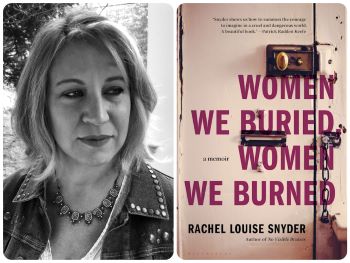The journalist talks survival, loss, and how opposing forces shape her writing.

Rachel Louise Snyder, whose seminal work on domestic violence, No Visible Bruises, was 10 years in the making, says she carried her new memoir, Women We Buried, Women We Burned, inside her for four decades. It tells a story of loss, familial abuse, survival, and, ultimately, forgiveness. Snyder, a 2020-2021 Guggenheim Fellow, is a professor of creative writing and journalism at American University in Washington, DC. She is also the author of several books and innumerable articles for publications including the New Yorker, the New York Times, and the Atlantic.
There is so much to unpack in your memoir. Let’s start with your mother’s death when you were 8, and what you describe as the “whiplash” that came next, when your father remarried, moved you and your brother from Pennsylvania to Illinois, and raised you as an Evangelical Christian.
Everything starts with my mother. In some ways, losing my mother was my primary, or initial, trauma. Before my mother died, we went to church with my father and synagogue with my mother. It’s hard to look at the series of decisions my father made after she died with anything other than shock. It can only be explained as the actions of a desperate man. He didn’t have any place to put his grief.
Your household with your blended family was physically abusive. You rebelled and eventually flunked out of high school. Things got so bad that, one day, you came home to four suitcases lined up at the door for you, your brother, and your two stepsiblings. That’s a stark image. What happened next?
It was brutal, but it didn’t occur to me to get help. Getting kicked out was scary, but in a strange way, I finally felt free of the horror show. I struggled but I grew up. I slept in my car and couch-surfed, but the world was safer than my house. I eventually got serious about my life, got my GED, and went to college at age 19.
In your prologue, you write about studying aboard a ship at sea and experiencing something you later learned was called “the Terminator”: “light began to break along the horizon, and the overhead sky appeared to cleave in half. Night on one side, dawn on the other. It was like a perfect seam in the sky.”
I vividly remember the Terminator. During the trip, the world that I’d been closed off from felt like it had burst wide open. I wanted to be off in the world and traveling. The trip eventually led to my journalism writing, but that actually took another five years.
The book unveils the opposing forces in your life: Being raised both Christian and Jewish; experiencing the ocean as both beautiful and dangerous; and seeing jazz music as “chaos into beauty.” How have such competing forces affected your life and writing?
There are direct examples of different forces in my life: Water is both beautiful and devastating; my father could be violent and incredibly loving and hilarious. I am attracted to complications. I never want a simple answer; I want complexity and all of its nuances. I am genuinely interested in people and their stories.
Your character arc here is powerful: grieving child, rebellious teenager, globetrotting journalist, mother, and, finally, empathetic and loving adult at the deathbed of your stepmother, Barbara. Tell us about her final days.
My stepmother gave me an incredible gift of graciousness. She allowed me to ask questions I couldn’t ask my mom when she was dying: Are you in pain? Are you afraid? Two questions that matter on a deathbed. Also, know that I love you. I feel the most intimate act is to watch somebody die; it’s more intimate than even birth. In order to share dying with someone, you let the artifice fall away and let them direct. My stepmother knew I was not a believer. Yet she still needed to say some things to me. She told me she saw Jesus as she waited to die. By then, I had learned not to judge. In Cambodia, I learned that people live among the spirits and believe in ghosts. Evangelicals just have a different language to talk about this — angels and demons — but it’s the same idea. It’s the unknowable place.
You say, “I write in order to explain.” What are some things you considered when writing this book?
I asked myself all of the possible reasons my father acted the way he did. Writing this forced me to be empathetic. To look at one’s own actions and behavior.
Sprinkled throughout the book are humorous one-liners.
You can’t be emotionally relentless when writing. There’s humor in there along with the grief.
Where does your title come from?
In a literal sense, there were women we buried and burned. My mom was buried, and my stepmother was cremated. The title is also a nod to systems of patriarchy whether in my life or someone else’s in another country. Women and children are the most affected by systems, whether they are formal government or informal family systems.
Memoirs often meander, but yours is well structured. Was shaping it difficult?
While life is shapeless, a memoir must have a shape. At some point, you have to determine the structure and the arc of the book. I left a lot out of the book. I left out details toward the end, such as my father dying and that I had breast cancer last year (I am fine now). It felt perfect how it ended and where it ended, purposeful.
[Photo by Don Rutledge.]
Therese Droste is a Washington, DC-based writer and member of the Independent’s board of directors. Her work has appeared in the Washington Post, Prevention, Health, Washingtonian, and numerous other publications.

